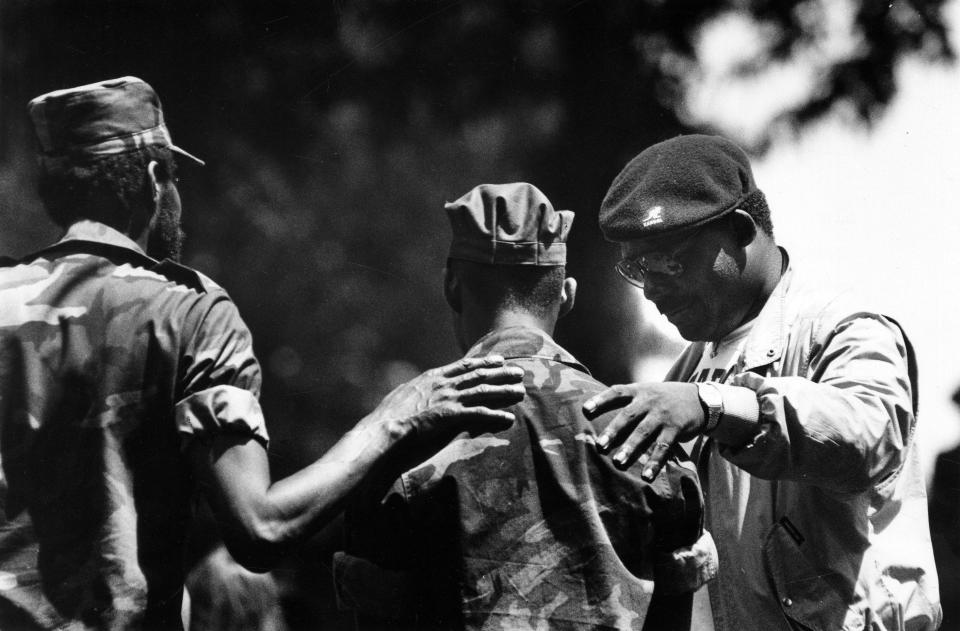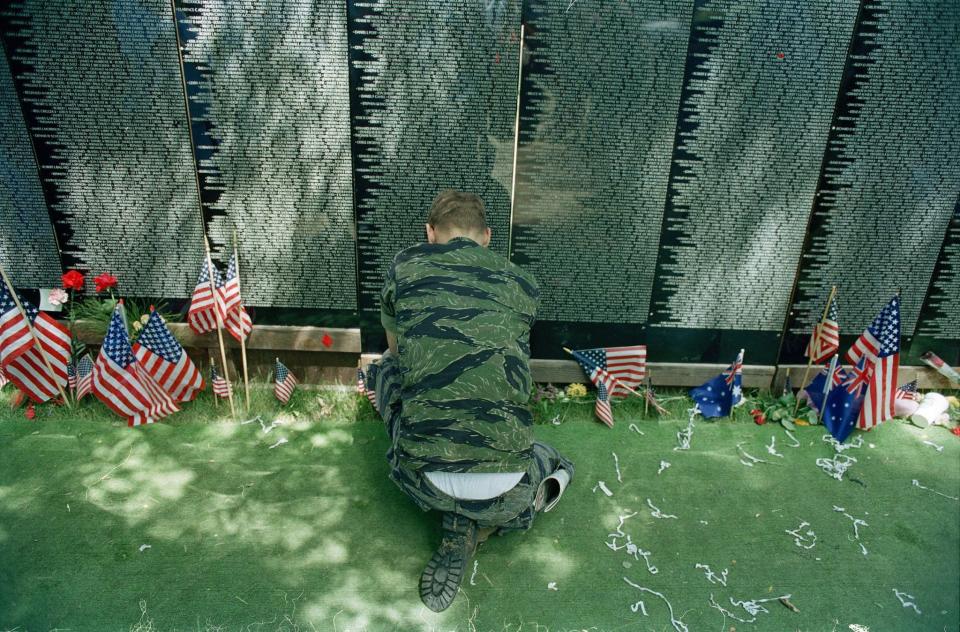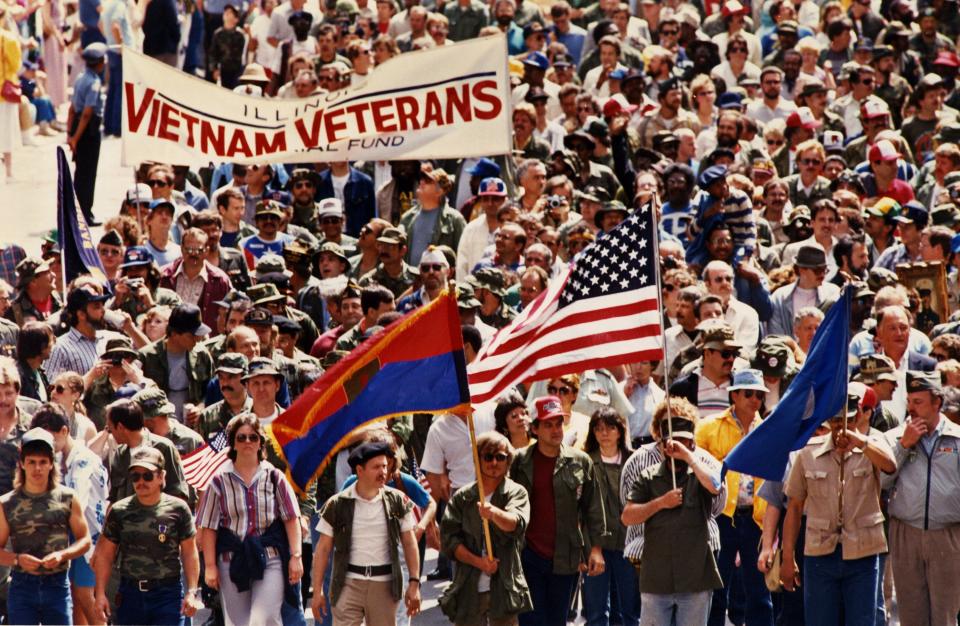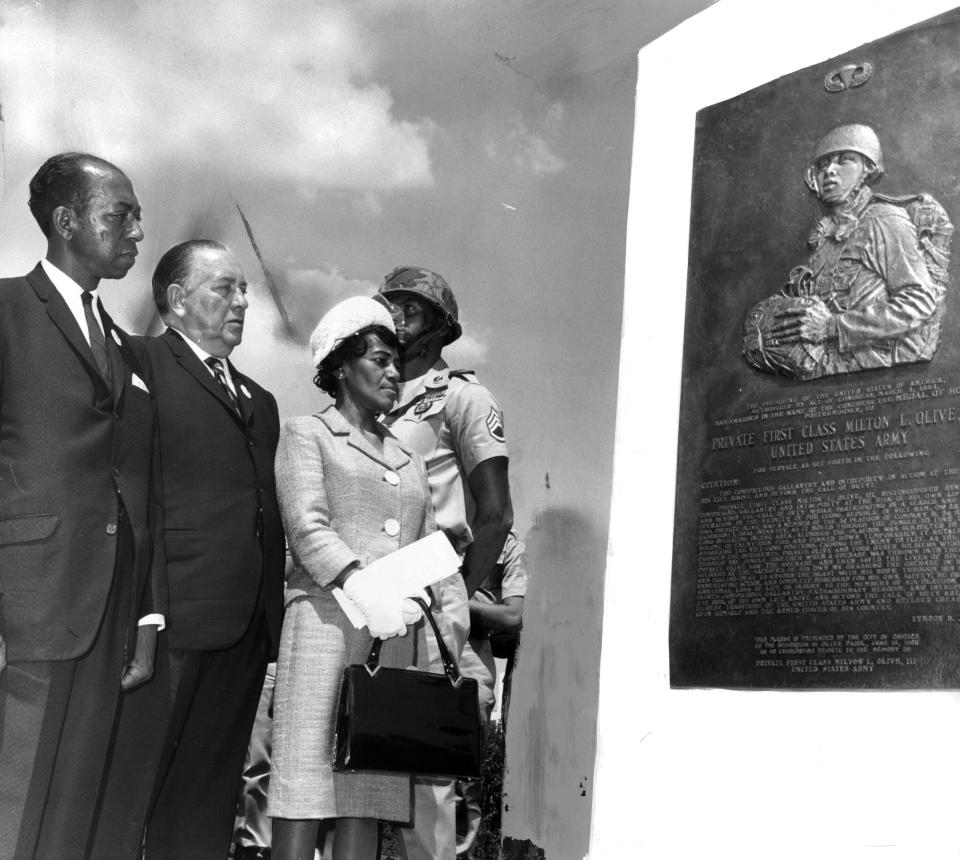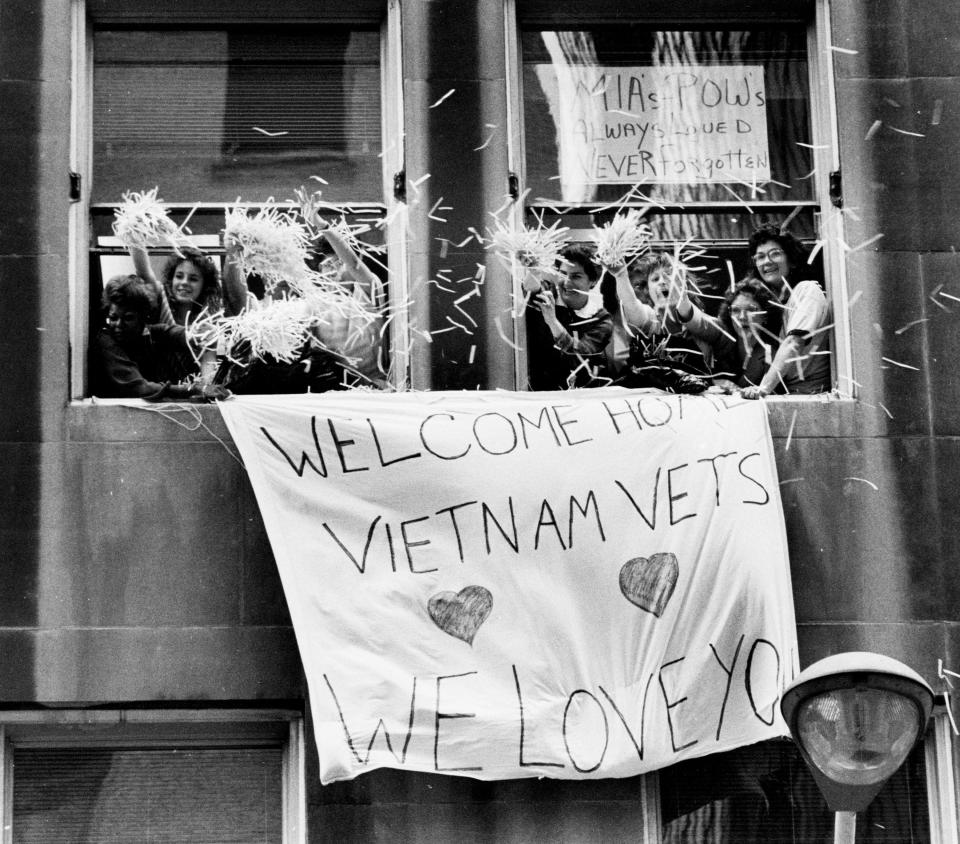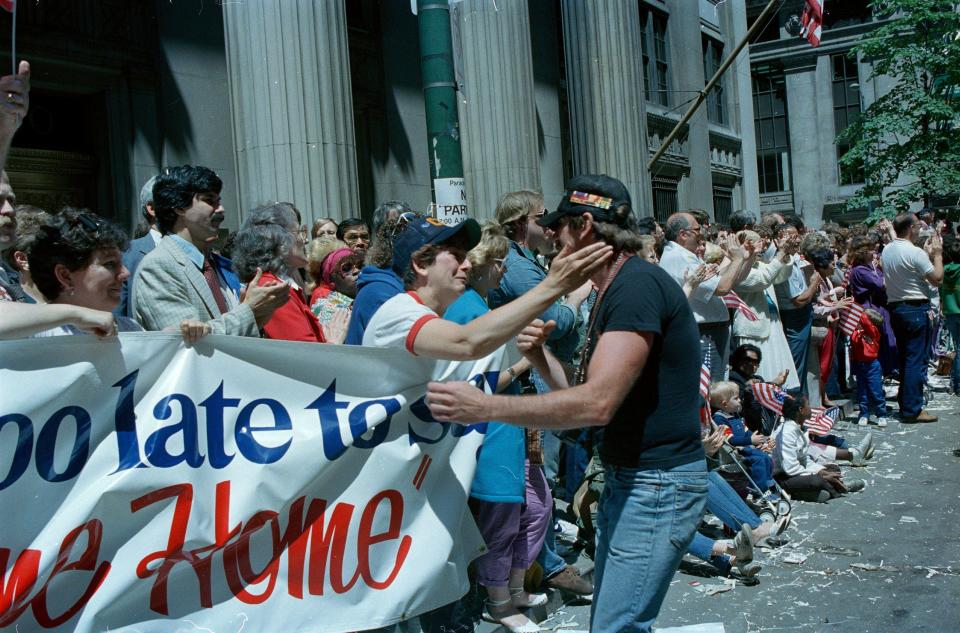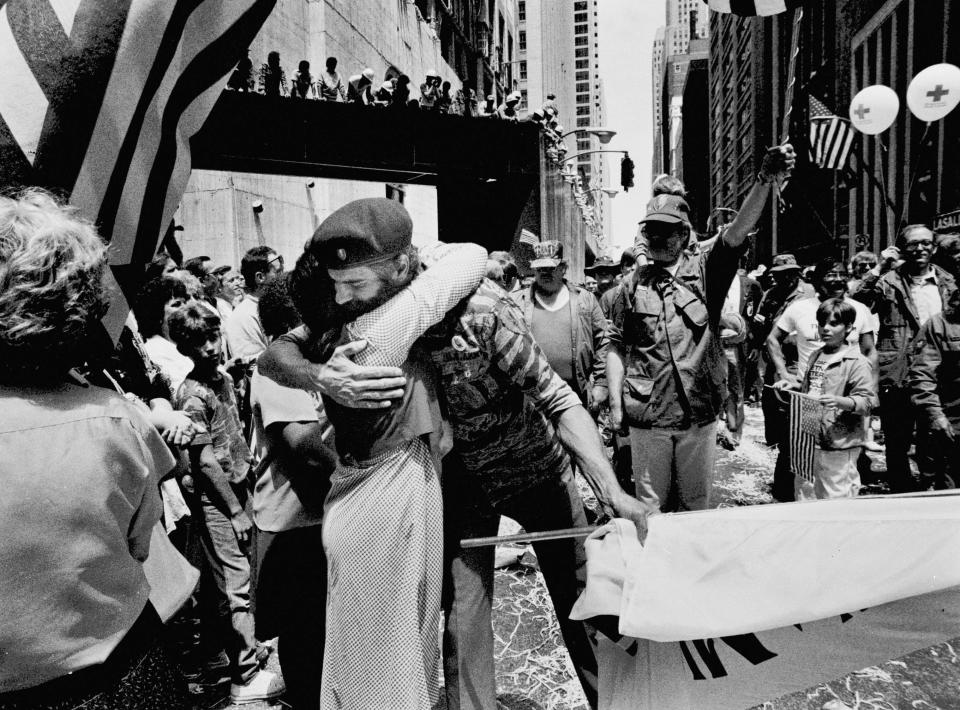Vintage Chicago Tribune: Vietnam Veterans Welcome Home Parade of 1986
The Vietnam Veterans Welcome Home Parade was one of the largest gatherings in Chicago history, but it has been quickly forgotten by time — just as the men and women who fought in the unpopular war had been, Thomas J. Stack believed.
Stack had been a sergeant who led a combat platoon with the U.S. Army’s 9th Infantry Division through Vietnam’s Mekong Delta region in the late 1960s. He was awarded two Silver Stars, three Bronze Stars and other honors along the way. But unlike soldiers from previous wars who were praised for their heroics, Stack said he was called a “baby killer” by an antiwar protester on the day he returned home from the war in 1969.
Sentiment for Vietnam veterans, however, began to change with time. The Vietnam Veterans Memorial was unveiled in 1982 on the National Mall in Washington, D.C. Then in 1985 — a decade after the war ended — more than 25,000 Vietnam veterans walked a “Route of Heroes” in the “It’s Time” parade in New York City before gathering to dedicate a memorial in lower Manhattan. Stack, then a criminal justice instructor at Richard J. Daley College, attended both of the deeply moving ceremonies. The experiences inspired him to plan a full weekend of similar events here.
For more than a year, Stack and a small group of fellow veterans “had sweated, cajoled, begged and borrowed the Chicago parade into existence,” Pulitzer Prize-winning Tribune reporter William Mullen wrote. It finally happened June 13, 1986, stepping off from Olive Park, which 20 years earlier had been named in honor of U.S. Army Pfc. Milton Lee Olive III, a Chicago native and the first Black officer in the Vietnam War to be awarded the Congressional Medal of Honor. More than 200,000 people came from around the United States to march in the parade — and up to another 500,000 lined up along the route to cheer and thank them.
Mullen almost missed it. He was on deadline for a Chicago Tribune Magazine story when he went to the ground floor of Tribune Tower for a cup of coffee. Two friends grabbed him as he was waiting for the elevator and ushered him outside.
“They would not listen to my protests that I had to get upstairs and finish a story — they said I could take 20 minutes off for this,” he recalled earlier this week. “So I went with them and we did indeed see the beginning of the parade with Gen. William Westmoreland (the commander of U.S. forces in Vietnam from 1964-1968). There was not much to it beyond endless groups of vets coming down the street, but I was simply riveted by it. The guys I came with left after 20 minutes. I could not let myself leave and watched the whole damned thing.”
He stood there for five hours.
“So I blew the deadline,” he said. “Mary Knoblauch, editor of the magazine at that time, was mad. A couple of days later, a dozen or more Tribune photographers — most of them Vietnam vets who shot hundreds of pictures of the parade — came to her office and begged her to devote an issue of the magazine to their pictures because the paper had used only three of them in print the day after the parade.
“She made no promises but called me in after they left. ‘What IS it about that parade that has stirred all this emotion?’ she asked me.
“I have no idea what I said, as on my feet I am not the most articulate person around, but she said if I would write a story explaining it, then she would devote an issue to their pictures. ...
“I more often than not cringe when reading many of my old stories, but that one I am pretty damned proud of. I still tear up when I read it nearly 40 years later.”
You can read Mullen’s full story from Aug. 17, 1986 here.
Want more vintage Chicago?
Become a Tribune subscriber: It’s just $12 for a 1-year digital subscription.
Follow us on Instagram: @vintagetribune.
And, catch me Monday mornings on WLS-AM’s “The Steve Cochran Show” for a look at “This week in Chicago history.”
Thanks for reading!
— Kori Rumore, visual reporter
Chicago history | More newsletters | Puzzles & Games | Today’s eNewspaper edition
‘There’s going to be a parade in this town, one everyone agrees is long overdue.’
“Though veterans now are balding and turning gray — though they’ve gained weight, gotten mortgages and had kids of their own — it’ll be the first real welcome they’ve ever received,” Tribune reporter Anne Keegan wrote in February 1986 after the parade was announced.
The funds to produce it, however, were limited.
“We need money real bad,’’ said Jeff Harvey, a disabled veteran running the parade office in space donated by Jefferies & Co. “We are running out of thread. We’ve got a great parade planned. Four times greater than the New York parade. But time is running out on us. Now we need to have some donations start coming in. We need seed money to keep this thing going.” Read more here.
Photo gallery: Vietnam Veterans Welcome Home Parade
“Chicago tried to mend its fences with America’s Vietnam veterans this weekend. It opened its heart and cheered them on, shook their hands, embraced them on the streets, showered them with ticker tape, bought them a beer, threw them a party in Grant Park two nights in a row and offered them their city for the weekend.” Tribune reporter Anne Keegan wrote on June 15, 1986. See more photos here.
Olive Park’s namesake: U.S. Army Pfc. Milton Lee Olive III
Olive Park, on the lakefront at the site of the city’s water filtration plant and adjacent to Navy Pier, was the starting point for the parade. It’s named for a soft-spoken South Side teen who was killed in Vietnam on Oct. 22, 1965, after throwing his body on a hand grenade to save the lives of four military companions.
Olive, whose nickname was “Skipper,” posthumously became the first Black officer who served in the Vietnam War to receive the Congressional Medal of Honor. Read more here.
Story from Oct. 29, 1965: Services today for Pfc. Olive, killed in Viet
Story from April 21, 1966: ‘It’s not an easy thing to be the father of a hero’
Story from June 20, 1966: Dedicate Olive Park to Viet war hero
Story from March 25, 1993: Milton B. Olive, made place in history for war hero son
June 13, 1986: ‘You realize how much these men needed this when you see how many men turned up’
On the 2.8-mile route, spectators began gathering as early as 8:30 a.m., with many persons tucking themselves into their old military uniforms to show their solidarity with those who would march. Gen. Westmoreland, its grand marshal, strode proudly at the front, flanked by two legless veterans, one in a wheelchair and the other smiling and pulling himself along the asphalt on his padded hands, arms and stumps of legs. Read more here.
Story from June 14, 1986: Fathers, families share a parade ‘they deserve’
Story from June 15, 1986: ‘All they wanted you to do was come and march. And I did.’
June 14, 1986: A dark day turned over to memory of the missing
“Our parade was yesterday. ... Today is for the guys who aren’t here. Hopefully, the next time we have a parade, they will be here,” said master of ceremonies Jerry Taft, a WLS-TV meteorologist and veteran, at the POW/MIA memorial in Daley Plaza. Read more here.
June 15, 1986: Weekend in Chicago was ‘full of reckonings with ghosts and nightmares, of reveling with old friends and new’
The weekend began with a ticker-tape parade and ended with thousands quietly gathered in Grant Park to view a half-size black plastic replica of the Vietnam Veterans Memorial. By Sunday night, the replica was dismantled and the vets, many dressed in camouflage fatigues, boarded buses, planes and trains to head home with memories of the welcome Chicago had given them.
“It makes you proud to be from Chicago,” said Richard Nissley, a former Marine who lived in River Forest. “The town did one hell of a job. If you didn’t find anybody you served with, and I didn’t, you found compadres.” Read more here.
Join our Chicagoland history Facebook group and follow us on Instagram for more from Chicago’s past.
Have an idea for Vintage Chicago Tribune? Share it with Ron Grossman and Marianne Mather at rgrossman@chicagotribune.com and mmather@chicagotribune.com.
